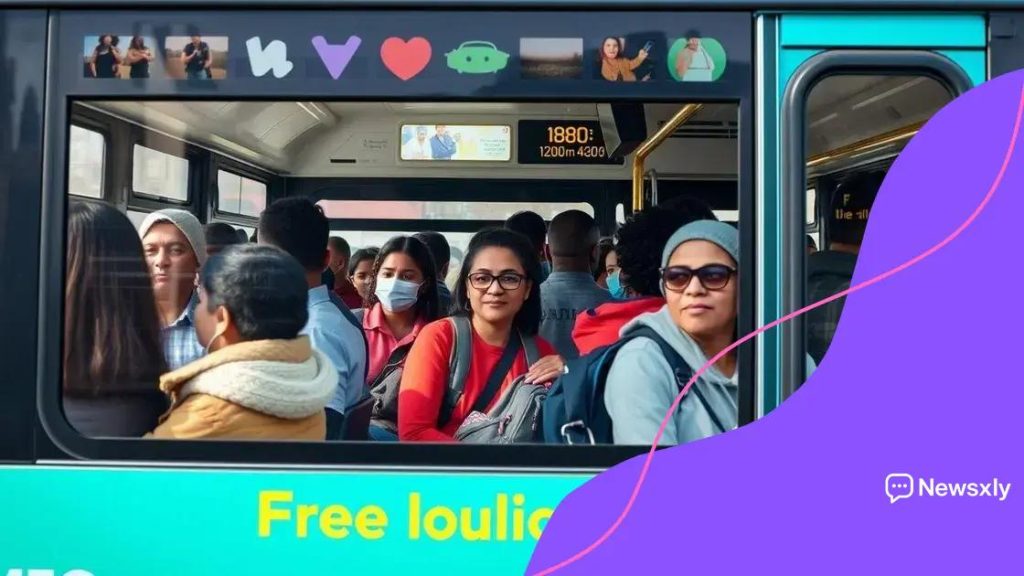Free bus travel for low-income individuals: a way forward

Free bus travel for low-income individuals significantly enhances access to essential services, job opportunities, and education while fostering community connectivity and supporting sustainable urban transport solutions.
Free bus travel for low-income individuals can significantly alter their daily lives, providing greater access to jobs and essential services. Have you considered how this could change your neighbor’s commute?
Understanding the need for free bus travel
Understanding the need for free bus travel is essential to addressing the mobility challenges faced by low-income individuals. Many rely on public transportation to access jobs, education, and healthcare services. Without affordable options, these community members often struggle to make ends meet.
The Importance of Accessibility
Accessibility in transportation can significantly impact a person’s quality of life. Free bus travel is a crucial step toward ensuring everyone can participate fully in society. By eliminating fare costs, cities can help reduce the burden on low-income families, allowing them greater freedom to travel.
Benefits of Free Bus Travel
When cities implement free bus travel, they contribute to not just individual well-being, but also community growth. Some notable benefits include:
- Increased access to jobs and training programs.
- Reduction in transportation costs for families.
- Lower traffic congestion and environmental impact.
- Improved public health through greater access to healthcare.
This initiative can also encourage more people to use public transport, which can lead to a decrease in carbon emissions and traffic congestion. Moreover, by making transportation more accessible, communities can foster inclusivity and connection.
Reducing Financial Burdens
A significant barrier for low-income individuals is the cost of commuting. By instituting free bus travel, cities can alleviate some of the financial pressure these families experience. Studies show that when transportation costs are reduced, families can allocate resources to other essential needs, such as food and healthcare.
In places where free bus travel has been adopted, we often see a notable positive shift in community dynamics. There are more opportunities for social interactions, improving overall community well-being. Recognizing and addressing the needs of low-income individuals through equitable transportation options is vital for building stronger, more vibrant communities.
Impact of free transportation on low-income communities
The impact of free transportation on low-income communities is profound. It directly affects various aspects of life, from economic stability to social engagement. When transportation is freely available, individuals can access opportunities that were previously out of reach.
Economic Opportunities
Free transportation opens up a world of job possibilities. When people can travel without worrying about fare costs, they can explore better employment options. This often leads to:
- Increased job applications and interviews.
- Higher rates of employment and job retention.
- Opportunities for career advancement.
In cities that have implemented free transportation, studies show a significant rise in job placements among low-income residents. This creates a cycle of economic growth within those communities.
Access to Education and Training
Education is another critical area that benefits from free transportation. Individuals can easily reach schools, colleges, and training centers. More accessible education leads to:
- Increased enrollment in schools and adult education programs.
- More opportunities for skill development and vocational training.
- Greater overall community literacy rates.
When education becomes accessible, communities can thrive. The knowledge gained will spread through families, breaking down barriers that have persisted for generations.
Moreover, access to health services also improves with free transportation. People can get to medical appointments, thereby enhancing overall public health. This reduction in transportation-related barriers can lead to fewer missed appointments and better health outcomes.
Ultimately, free transportation fosters greater connectivity among residents. As people travel more freely, community ties strengthen. Social events, cultural programs, and local organizations see increased participation. Active communities tend to be more vibrant and supportive, creating a sense of belonging for everyone involved.
Success stories: cities implementing free bus travel

Success stories of cities implementing free bus travel highlight the transformative effects on communities. These real-life examples offer valuable insights into how removing fare costs can enhance public transportation systems.
Case Study: Dunkirk, France
Dunkirk made headlines by becoming one of the first cities to offer free public transport. This initiative resulted in a dramatic increase in ridership. With no fare barriers, residents found it easier to travel for work and leisure, leading to:
- A 60% rise in bus usage within the first year.
- Improved air quality due to reduced car emissions.
- A boost in local businesses as more customers traveled to shops and restaurants.
This success has inspired surrounding areas to consider similar initiatives.
Impact in Estonia
In Estonia, the capital city of Tallinn initiated a program that allowed for free bus travel for residents. This decision had far-reaching benefits. Notably:
- Public transport ridership increased significantly among low-income residents.
- Congestion decreased, improving overall traffic flow.
- Local government reported increased commuter satisfaction.
The program turned Tallinn into a model for other cities looking to improve accessibility through public transport.
Another example is the city of Chengdu in China, where local authorities offered free public transport during specific hours. This initiative was aimed at encouraging off-peak travel and assisted in reducing traffic during peak hours. This strategy reaffirmed the effectiveness of free bus travel not only for financial relief but also for traffic management.
These stories provide compelling evidence that free bus travel can lead to enhanced community engagement, environmental benefits, and economic growth. By examining these successful models, other cities can learn valuable lessons on implementing similar programs.
Challenges in providing free bus services
Providing free bus services comes with unique challenges that cities must navigate. While the benefits are significant, several obstacles can hinder the successful implementation of such programs.
Funding and Budget Constraints
One major challenge is securing funding. Free services require substantial financial resources, which can strain city budgets. Without adequate funding, maintaining bus quality and frequency becomes difficult. Cities must explore various solutions to cover these costs, including:
- Government grants and subsidies.
- Partnerships with local businesses.
- Community fundraising efforts.
Relying solely on one source of income may not be sustainable in the long term.
Public Perception and Acceptance
Another challenge is public perception. Some citizens may question the feasibility of free bus services and doubt the quality of the service. Overcoming skepticism requires effective communication about the program’s benefits. Engaging the community through:
- Public meetings and forums.
- Social media campaigns.
- Information sessions at community events.
Such actions can help foster trust and enthusiasm among residents.
Operational efficiency is also crucial. Managing increased ridership without compromising service quality can be difficult. As more people begin to use the free bus system, cities must ensure that buses are running on time and adequately staffed. It’s essential to monitor and adapt the system to meet growing demand.
Additionally, cities may face logistical issues, such as route planning and scheduling. To optimize routes, it’s vital to consider where low-income individuals typically reside and where they need to travel. This requires careful planning and community input to ensure the service is accessible and meets real needs.
Despite these challenges, cities can successfully implement free bus services with the right strategies. Collaboration between government, businesses, and community members is essential for overcoming barriers and ensuring the program’s sustainability.
Future prospects for public transportation accessibility
The future prospects for public transportation accessibility look promising, especially with initiatives like free bus travel gaining momentum. As cities around the world recognize the importance of accessible transportation, they are exploring innovative solutions to enhance mobility for all residents.
Advanced Technology Integration
One exciting development is the integration of technology into public transport systems. Smart apps and real-time tracking can significantly improve user experience. By providing timely information about bus arrivals and service disruptions, technology can help:
- Reduce wait times for passengers.
- Enhance reliability and efficiency of bus services.
- Promote ridership by making travel more convenient.
Moreover, these technologies can be designed to be user-friendly for everyone, including those with disabilities.
Focus on Sustainability
Future public transportation plans increasingly focus on sustainability. As cities aim to reduce their carbon footprint, public transport systems are evolving to include more eco-friendly options. This includes:
- Electric and hybrid buses to reduce emissions.
- Investment in a network of bike lanes and pedestrian-friendly pathways.
- Collaboration with car-sharing services to reduce reliance on personal vehicles.
By combining these sustainable transportation methods, cities can offer residents diverse options that meet their needs.
Accessibility remains a central focus. Future public transport initiatives must prioritize inclusivity for the elderly and individuals with disabilities. Planning accessible routes, providing transportation options that accommodate wheelchairs, and training staff to assist those with special needs are all essential steps forward.
As communities continue to advocate for free bus travel and more accessible transit systems, partnerships between city planners, government, and local organizations will be vital in driving these changes. Long-term investments into infrastructure and services aimed at leveling the playing field can lead to a more connected and equitable society.
FAQ – Frequently Asked Questions about Free Bus Travel for Low-Income Communities
What are the benefits of free bus travel for low-income individuals?
Free bus travel provides greater access to jobs, education, and healthcare, improving overall quality of life.
How can cities fund free bus services?
Cities can secure funding through government grants, local business partnerships, and community fundraising efforts.
What challenges do cities face when implementing free bus services?
Cities may face funding constraints, public skepticism, and the need for efficient management of increased ridership.
How does technology improve public transport accessibility?
Technology enhances user experience with real-time tracking, mobile apps, and better communication, making travel easier and more efficient.





